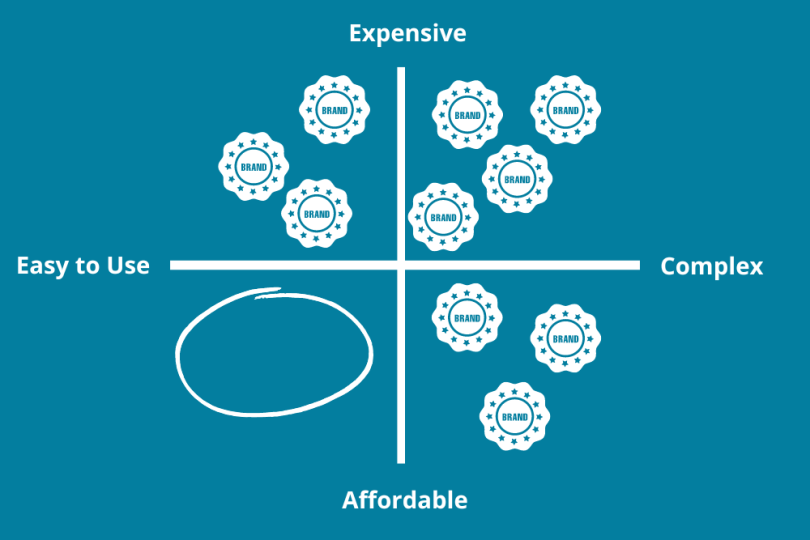What’s your secret sauce? What makes your brand unique? Why would consumers reach for your product, rather than that of your main competitor? These are the questions that haunt marketers and startup founders alike.
Brand positioning is the marketing strategy that seeks to provide an answer.
What Is Brand Positioning?
What Is Brand Positioning?
Brand positioning is the act of influencing your target customers so they think about your company’s product or service exactly the way you want them to. Whether you want your brand to be perceived as “affordable, no-frills,” “exotic and luxurious” or “edgy and youthful,” the goal of positioning is to help consumers think about your brand the “right way” — so they have a clear, compelling reason to buy from you instead of your competitors.
To successfully stand out from the crowd, brands need to define themselves as distinct from, not better than, their competition. That means carving out a niche, rather than copying what everybody else already does. And it requires clarifying what your brand is all about and what makes it unique in the marketplace to satisfy the needs of consumers.
As a formal concept, positioning can be traced back to the work of Al Ries and Jack Trout, who distilled their ideas in the classic marketing book Positioning. In it, Ries and Trout sketch out three distinct eras in marketing. First came the product era of the 1950s, when marketing messaging focused on products’ features and usefulness; then came the image era, ushered in by David Ogilvy (and re-hashed in Mad Men), when advertising focused more on creativity and holistic reputation. By the 1970s and 1980s, Ries and Trout argue, a third era had arrived — the positioning era.
Effective marketing no longer needed to be slick or inventive, it just needed to be strategic, concise and clear.
Why Brand Positioning Is Important
Marketers today are addressing consumers who are overwhelmed with choices. And well-positioned brands give consumers some clarity, allowing them to make quick purchase decisions, free from having to pore over every product feature and carefully weigh the pros and cons of each option.
So to be successful and gain a competitive advantage in the marketplace, a brand must ensure it is positioned in such a way that target customers are able to immediately get a sense of what it’s all about and how its offerings uniquely solve their particular needs.
Brand positioning, as a strategic exercise, also helps companies clarify what they want to be about.
“Positioning permeates the fabric of a company,” according to marketing professor Michael Richarme. “Marketers should adopt positioning as their fifth ‘P’ and utilize it in conjunction with the other four “P’s” learned in school” — product, price, place and promotion.
In Positioning, Ries and Trout wrote that “the mind accepts only that which matches prior knowledge or experience.” This is why it’s hard to convince people they’re wrong, and why it’s hard to sell anything totally unfamiliar. It’s much more viable, they argue, to build on what people already know.
“So a company doesn’t start with the product or the product’s advertising,” Ries told Built In — at least, not if it wants to be heard. “A company starts with the mind of the prospect and asks itself, how can I relate my product to what already exists in my prospects’ minds.”
This is why a startup may market itself as “Uber for pets” or “Salesforce for kitchen counter companies” or “instant coffee that tastes like a craft pour-over.” Positioning gives consumers a frame of reference from which to make a decision. And ideally, it spotlights the distinctive attributes that appeal to the brand’s target customers, be it low price, high quality, healthy ingredients or more horsepower.
“There is no reality,” Ries said. “There are only perceptions in minds.”
How to Develop a Brand Positioning Strategy
To build a brand positioning strategy from scratch — or improve upon an existing one — marketers need to understand their target customers, their product’s unique value proposition and what their main competitors offer. From there, they can develop a positioning statement that encapsulates the distinctiveness of their brand. After that, the brand’s positioning will want to be clearly, compellingly communicated — and reinforced — through promotional activities.
Identify Your Target Customer
First things first, pinpoint who you’re trying to reach and what they want. To get started, consider creating user personas (archetypal profiles that summarize a customer’s characteristics and goals) or ideal customer profiles (if your target customer is another business). Either way, you should be conducting customer research to get inside the heads of the people to whom you’re trying to market your product.
Ask yourself: What are their pain points? Where do they experience friction and frustration? What are their unmet needs? It’s only by answering these questions that you will be able to uncover how your brand or product can uniquely satisfy customers in a way your competitors aren’t or can’t.
Determine Your Competition
Speaking of competitors: If a key part of a positioning strategy is differentiating yourself from the other players in your market category, you better figure out who they are and what consumers perceive their strengths and weaknesses to be.
And unless you’re working in an extremely niche or new market, chances are you have more than one competitor. So start by making a list of three to five top competitors. From there, scope out their products, messaging and marketing channels. Ask yourself what bases these brands already cover and what customer pain points they already address.
Figure Out What Makes Your Brand Unique
Your brand needs to offer customers something that nobody else on the market does. It could be extremely low prices, or high convenience, or FOMO-inducing luxuriousness — as long as it’s a combination of attributes that’s virtually non-existent and yet still strongly desired by your target audience.
Fill a Gap in the Market
By this point in the brand positioning process, it should be clear where opportunity lies. To help you actually see where the opportunity lies, you can make a perceptual map, or a positional map, as it’s sometimes called.
“Perceptual mapping is a tool used by marketers to visually depict consumer perceptions, their prioritizing of brands and the perceived attributes of these brands,” wrote the authors of one marketing textbook. “It enables the relative standings of competing brands to be comprehended.”
Positional mapping is typically done by creating a vertical axis and a horizontal axis, each representing a different attribute that your target customer finds important. “Quality” and “price” is a classic combination. “Luxury” and “convenience” work too. Or maybe it’s “healthy ingredients” and “tastiness,” if you’re angling to enter the breakfast cereal market. Next, plot your competitors where they belong on the map. Remember: This should be where target customers think your competitors fit on the map, not where you think they should belong.
Once that’s done, look for any unoccupied spots on the map. There lies the opportunity to position your brand as the one that can meet that specific need for consumers.


Communicate Your Brand’s Unique Value and Benefits
At this point in the process, it may be helpful to write out a positioning statement that summarizes everything you’ve learned.
The classic brand positioning statement template goes something like this:
For [your audience] that need [your category or segment], our brand provides [your unique benefits] because [evidence backing up your unique benefits], unlike [your competition].
Using a fictitious cereal company, a brand positioning statement could be written as:
For health-conscious parents who need kid-friendly breakfast options, CinnaMoon provides great taste and is actually good for you, using all-natural, simple ingredients and no artificial flavors, unlike XYZ brands that rely on high amounts of sugar and hard-to-pronounce fillers and preservatives.
You can also end your brand positioning statement with your brand promise. For example: “At CinnaMoon, we believe all families should start their days off right.”
Now, with a brand positioning statement in hand, along with all the knowledge you accumulated in the process, the next step is actually implementing all of this. That means your pricing, logo and design, messaging and distribution all need to align with and reinforce your brand positioning.
Brand Positioning Examples
To get a better idea of what brand positioning looks like in action, consider these examples.
BMW
When the German carmaker roared onto American shores in the early 1980s, it positioned its brand as the only one whose cars offered both performance and luxury. In other words, in the minds of consumers, BMW matched luxury cars in luxuriousness but surpassed them in performance, and it kept up with performance cars in terms of performance but beat them in luxury. The company was able to pull this off by “relying on the design of its cars, its German heritage, and other aspects of a well-designed marketing program,” wrote Keller in Strategic Brand Management. BMW’s iconic slogan — “the ultimate driving machine” — helped reinforce this strategic positioning.
Dollar Shave Club
Dollar Shave Club made a splashy debut with its irreverent YouTube video back in 2011, and the brand promptly went viral. But more than just humor resonated with audiences. The company distinguished itself from the main competition, Gillette, by promising low prices (it’s in the name!), convenience (they shipped directly to customers’ doors before DTC was trendy) and a streamlined selection of razor blades with an intentional lack of fancy features. This combination of attributes made Dollar Shave Club stick out enough that it was bought by Unilever for a billion dollars just five years later.
Apple
Today, Apple is the most valuable company in the world. But back in the late 1990s, it was in dire straits. To revitalize the brand, Apple rolled out its “Think Different” campaign, the cornerstone of which was an iconic commercial that positioned Apple as the computer brand most preferred by creatives, innovators and people who think outside the box. This positioning stood in marked contrast to other computer brands, which at the time were seen as mainly playing in the realm of professionals and people with pocket protectors.




